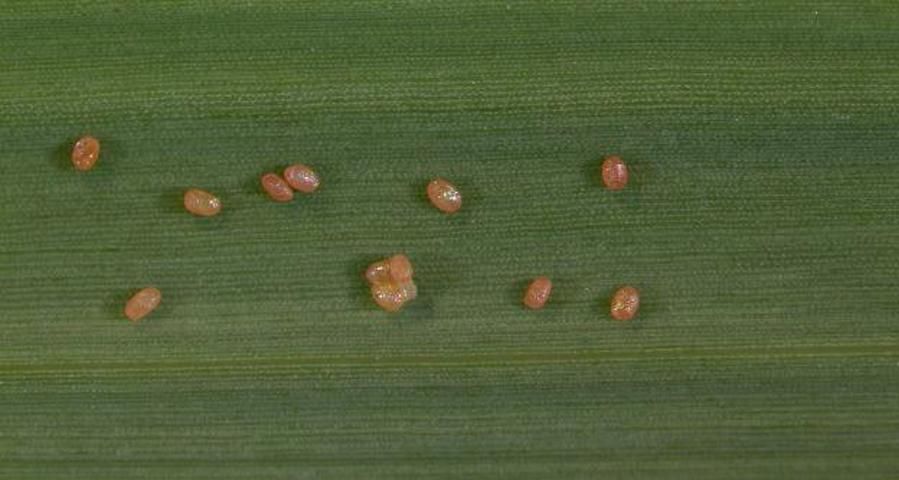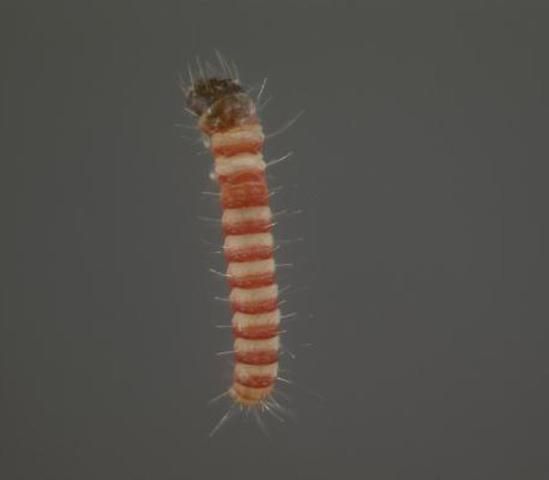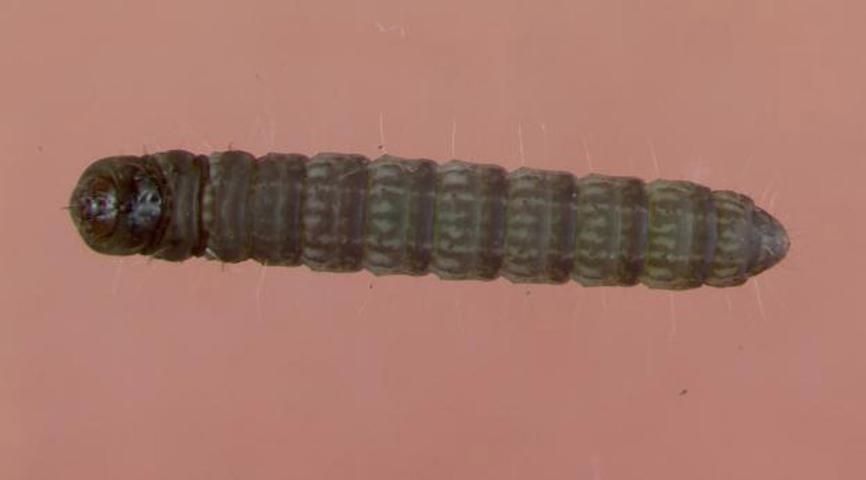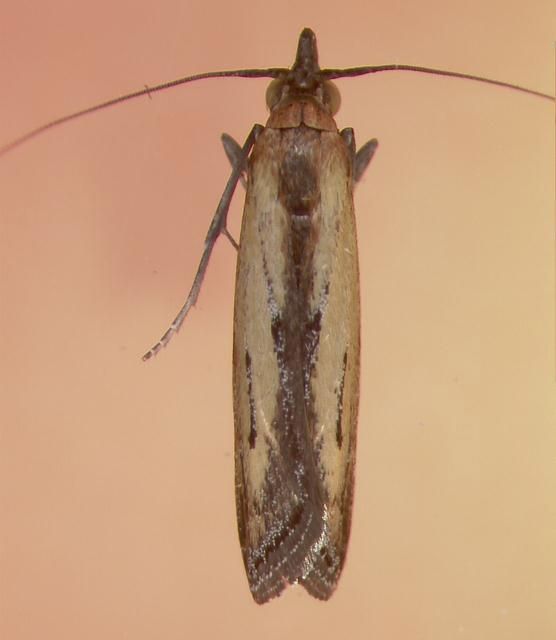Distribution and Crop Damage
The lesser cornstalk borer (Elasmopalpus lignosellus) is widely distributed in the tropical through temperate regions of the Americas, including Hawaii and the southern half of the United States from California to the Carolinas, north on the east coast to Massachusetts, and south through Central and South America to Argentina, Chile, and Peru. Lesser cornstalk borer attacks a large number of crops, including corn, peanuts, field peas, beans, soybeans, wheat, barley, oats, rice, cotton, cowpeas, nurseries of forest trees, and sugarcane. It was first reported to attack sugarcane in Jamaica in 1959, and since then it has been recognized as a potentially serious pest of this crop. Lesser cornstalk borer larvae bore into young sugarcane plants just below ground level, feeding on the tender plant tissue. This feeding habit can damage the growing point of the young plant, resulting in "dead heart" (or death of the sugarcane shoot) (Figure 1). Non-lethal damage can occur when the larvae chew only a few millimeters into the shoot, leaving a row of symmetrical holes across the emerged leaf surface and often causing the expanded leaf to break off, resulting in a loss of photosynthetic production. Large lesser cornstalk borer populations can cause significant loss of shoots and leafy material, resulting in poor crop stands, loss of growth potential, and ultimately loss in production.

Credit: G. S. Nuessly, UF/IFAS
Commercial sugarcane is planted vegetatively, using mature stalks as the planting material for the next crop. In Florida, new fields are normally planted from September through December and often into January. Late-planted fields are particularly susceptible to stand-reducing lesser cornstalk borer attacks since shoot emergence during January through May occurs during environmental conditions that favor rapid increases (two- to eight-fold) in lesser cornstalk borer populations. This is also the dry season for south Florida, and dry soil surfaces are ideal for lesser cornstalk borer oviposition and survival of immature lesser cornstalk borer life stages. Sugarcane is typically harvested annually for 3–4 growing seasons, which includes the harvest of the initial plant cane crop followed by annual ratoon (re-growth) harvests. After the "plant" sugarcane crop is harvested, it is allowed to grow back from the original root/stubble complex (stool), which produces a "ratoon" crop. Shoots produced in early-harvested fields (October through November) are normally less vulnerable because of steadily declining lesser cornstalk borer populations during the preceding wet summer months. Ratoon-crop shoots emerging in fields harvested mid-December through April face the same elevated lesser cornstalk borer damage potential as plant cane fields. However, because stools in ratooned sugarcane are already well-established, lesser cornstalk borer effects on early vigorous shoot re-growth are more of a yield-reduction concern than poor stand establishment.
Life Cycle
The lesser cornstalk borer undergoes complete metamorphosis with well-defined egg, larval, pre-pupal, pupal, and adult stages. The literature indicates that the lesser cornstalk borer life cycle can vary with the host crop. For example, larval duration was 15.6–16.9 days in cowpeas (Luginbill and Ainslie 1917), 33 days in southern peas (Dupree 1965), 13–24 days in soybean (Leuck 1966), and 15.5–65.7 days in sugarcane (Sandhu et al. 2010).
Eggs
The majority of eggs are deposited in the soil around the sugarcane plant base in south Florida. The ovate-shaped eggs are creamy white when deposited but turn crimson within a day of larval emergence (Sandhu et al. 2010) (Figure 2). Egg developmental time varies with temperature, ranging from 1.8 days at 91.4°F to 17.5 days at 55.4°F. Average egg survival increases with an increase in temperature from 50.3% at 55.4°F to 92.7% at 80.6°F and then decreases with further increases in temperature. The estimated optimum threshold for egg development is 88.3°F, while the minimum and maximum thresholds are 53.2°F and 99.1°F, respectively (Sandhu et al. 2010).

Credit: H. S. Sandhu, UF/IFAS
Larvae
The lesser cornstalk borer larvae are easily distinguished in the field by their vigorous wriggling motion when disturbed. The first instar larvae are crimson red with white bands (Figure 3). During later instars, longitudinal stripes start to develop and become well pronounced around the fifth instar. Mature larvae are bluish green with fairly distinct yellowish stripes running along the back (Figure 4). Larvae produce silken tunnels that start within the soil and are attached to the sugarcane shoots on the other end. The larvae enter the sugarcane shoots through these tunnels, feed on plant tissues, and then return to the tunnels to rest. Larvae also molt and pupate within these silken tunnels.

Credit: H. S. Sandhu, UF/IFAS

Credit: H. S. Sandhu, UF/IFAS
We studied development of lesser cornstalk borer reared at nine constant temperatures (ranging from 55.4°F to 96.8°F) in the laboratory to better understand its development on sugarcane (Sandhu et al. 2010). We found six larval instars, and the average developmental time for larvae ranged from 15.5 days at 91.4°F to 65.7 days at 55.4°F. Temperature had a significant effect on the development of all six instars. Developmental time was shortest in the first instar and longest in the sixth instar at all temperature treatments. Larval survival increased with increasing temperature, peaking at 80.6°F, and then decreased with higher temperature. At extreme temperatures (55.4°F and 96.8°F), larval survival was less than 50%.
Pre-Pupae
The pre-pupal stage is the inactive stage that occurs immediately before pupal formation, at which time the larvae stop feeding in preparation for pupation. The average pre-pupal development time ranged from 1.3 days at 91.4°F to 10.5 days at 55.4°F, with pre-pupal survivorship increasing from 45.5% at 55.4°F to 92.1% at 80.6°F.
Pupae
Pupation occurs in silken tunnels and soil in sugarcane. Initially, the pupae are pale green to greenish-yellow with yellowish abdominal segments (Figure 5). Over time, the pupal body turns brown and eventually a uniform blackish-brown. A row of six hooked spines is arranged crosswise on the tip of the abdomen. The terminal abdominal segment is round on male pupa and irregularly shaped on female pupa.

Credit: H. S. Sandhu, UF/IFAS
The time between pupal formation and adult emergence (pupal duration) varies with temperature. Pupal duration is longer at low temperatures and becomes shorter with increasing temperatures. In our temperature dependent study, we found that pupal duration ranged from an average of 5.9 days at 91.4°F to 29.5 days at 55.4°F, when larvae were reared on sugarcane. Pupal survival increased from 51% at 55.4°F to 95% at 80.6°F, and then decreased with further increases in temperature, dropping to 52.6% survival rate at 96.8°F (Sandhu et al. 2010).
Adults
The lesser cornstalk borer adult is a linear-shaped moth with narrow forewings that are folded over the back and sides of the body while in resting position. Sexes can be easily differentiated by the color of the forewing. The female has uniformly dark brown or carbon black forewings (Figure 6), while males have light brown forewings margined with dark brown (Figure 7). In sugarcane fields, moths make short, jerky flights when disturbed, typically landing on the soil surface instead of plants. Darkness, still air, low humidity, and warm temperature all favor adult activity. Mating and egg deposition occur during dark periods, especially before midnight.

Credit: H. S. Sandhu, UF/IFAS

Credit: H. S. Sandhu, UF/IFAS
The time period from adult moth emergence until the female begins depositing eggs can vary from 9.7 days at 55.4°F to 2.3 days at 91.4°F. Once egg production begins, the female moth will produce and deposit eggs for a maximum of 5.6 days at 80.6°F. The number of eggs deposited per female per generation is also affected by temperature, increasing from an average of 29.2 eggs at 55.4°F to 165.3 eggs at 86°F.
Life Table Parameters
Life table parameters can be very important in understanding the population fluctuations of lesser cornstalk borer during a sugarcane growing season. On sugarcane, lesser cornstalk borer population growth rate increased when temperature increased from 55.4°F to 86°F, followed by population declines once temperatures increased to 91.4°F and above. The net reproductive rate (female/female/generation) was greatest at 80.6°F, and the average time between successive generations decreased from a maximum of 130.7 days at 55.4°F to a minimum of 27.7 days at 91.4°F. The time it takes for a population of lesser cornstalk borer to double in size can range from a maximum of 47.6 days at 59°F to a minimum of 5.6 days at 86°F. Temperatures within the range of 80.6°F to 91.4°F are typically the most favorable for survival and reproduction. Based on these life table parameters, predictive models can be used to estimate lesser cornstalk borer population fluctuations during the sugarcane growing season.
Population Predictions
Based on the results of this temperature dependent study, lesser cornstalk borer population predictions can be used as an aid to improve lesser cornstalk borer management in Florida sugarcane. Using population models and historic air temperature data from UF/IFAS FAWN weather stations in Belle Glade and Clewiston (http://fawn.ifas.ufl.edu/), both located within the sugarcane growing region of south Florida, lesser cornstalk borer populations were predicted to increase from two times during the month of January to eight times during the month of May.
Additional information is necessary to be able to more precisely predict lesser cornstalk borer populations in the field, including the relationship between air temperatures and temperatures inside the sugarcane shoots and in the soil where larvae feed and live, as well as differences between the relative attractiveness of laboratory material used as substrates for egg deposition in controlled environments versus the natural substrates of plant tissues and the soil surface. Predictive population models that best fit experimental results will require field testing before the models can reach their full potential to predict lesser cornstalk borer populations in the field.
For further information on lesser cornstalk borer, readers are suggested to read other EDIS documents such as Cherry and Nuessly (2011), Nuessly and Webb (2010), and Gill et al. (2008).
References Cited
Beuzelin, J. M., R. H. Cherry, G. S. Nuessly, and H. S. Sandhu. 2019. Insect Management in Sugarcane. ENY-406. Gainesville: University of Florida Institute of Food and Agricultural Sciences. https://edis.ifas.ufl.edu/ig065.
Dupree, M. 1965. "Observations on the Life History of the Lesser Cornstalk Borer." J. Econ. Entomol. 58: 1156–57.
Gill, H. K., J. L. Capinera, and R. McSorley. 2020. Lesser Cornstalk Borer, Elasmopalpus lignosellus (Zeller) (Insecta: Lepidoptera: Pyralidae). EENY155. Gainesville: University of Florida Institute of Food and Agricultural Sciences. https://edis.ifas.ufl.edu/in312.
Leuck, D. B. 1966. "Biology of the Lesser Cornstalk Borer in South Georgia." J. Econ. Entomol. 59: 797–801.
Luginbill, P., and G. G. Ainslie. 1917. "The Lesser Cornstalk Borer." USDA Entomol. Bull. 529.
Nuessly, G. S., and S. E. Webb. 2019. Insect Management for Sweet Corn. ENY-472. Gainesville: University of Florida Institute of Food and Agricultural Sciences. https://edis.ifas.ufl.edu/ig158.
Sandhu, H. S., G. S. Nuessly, S. E. Webb, R. H. Cherry, and R. A. Gilbert. 2010. "Temperature-dependent Development of Lesser Cornstalk Borer, Elasmopalpus lignosellus (Lepidoptera: Pyralidae) on Sugarcane under Laboratory Conditions." Environ. Entomol. 39: 1012–20.
Sandhu, H. S., G. S. Nuessly, S. E. Webb, R. H. Cherry, and R. A. Gilbert. 2013. "Temperature-dependent Reproductive and Life Table Parameters of Elasmopalpus lignosellus (Lepidoptera: Pyralidae) on Sugarcane." Fla. Entomol. 96: 380–390.